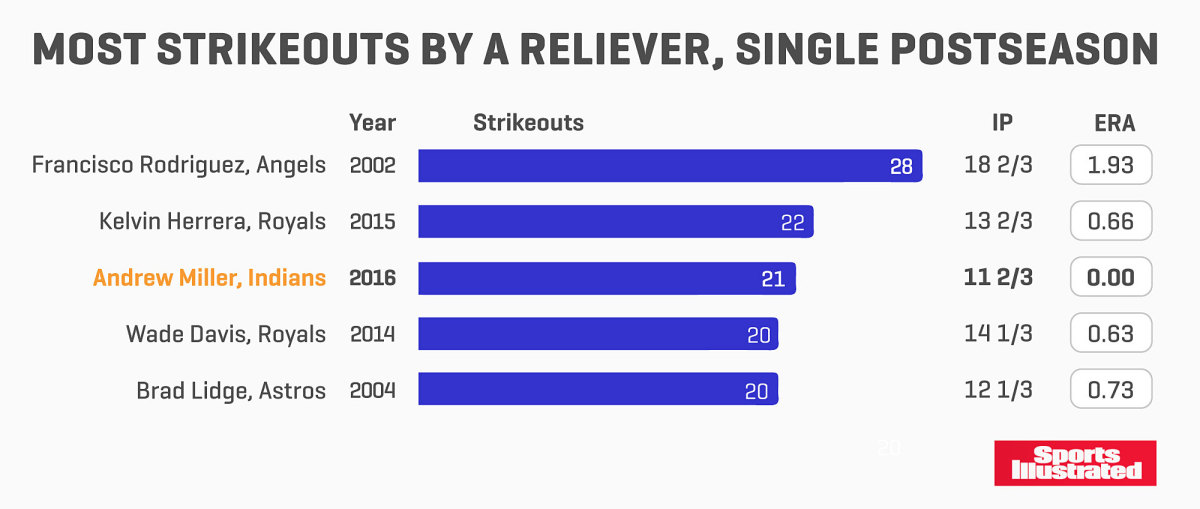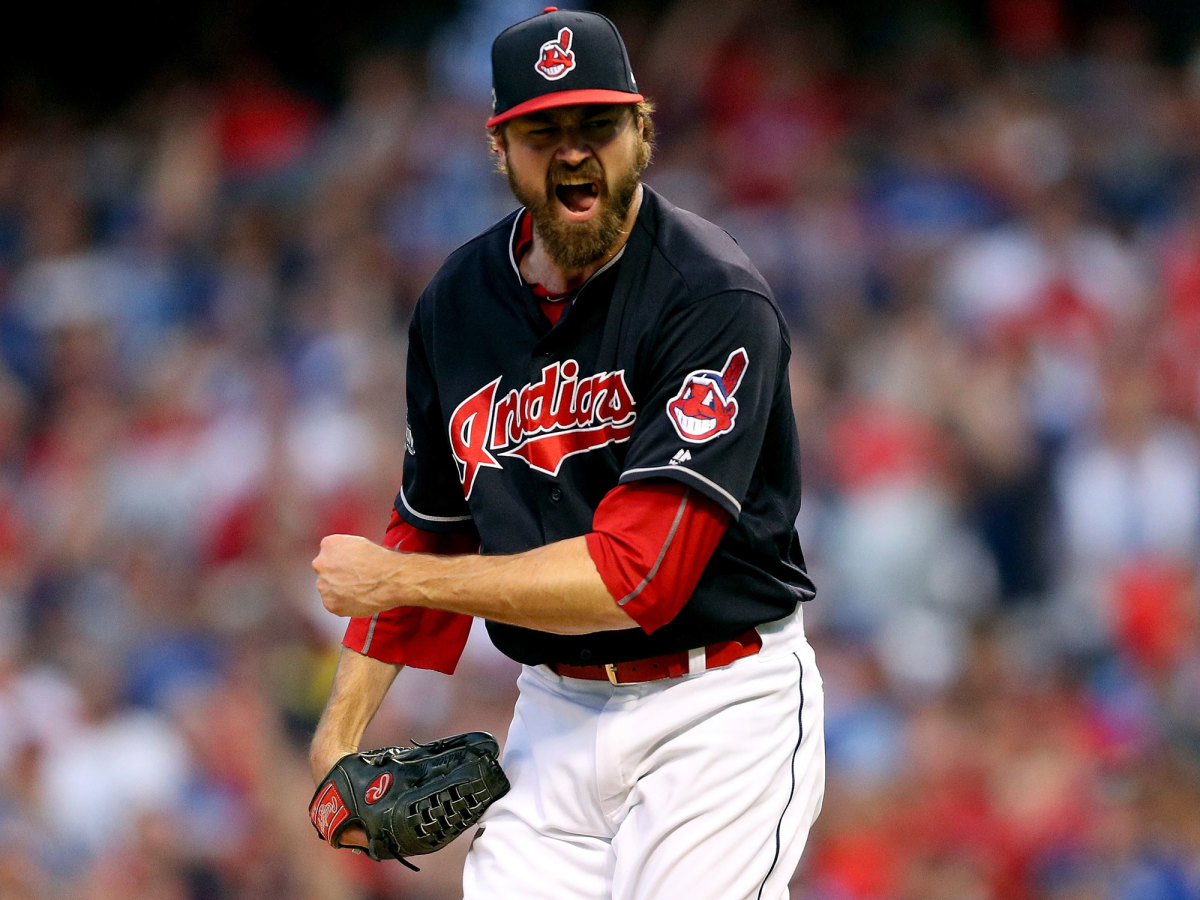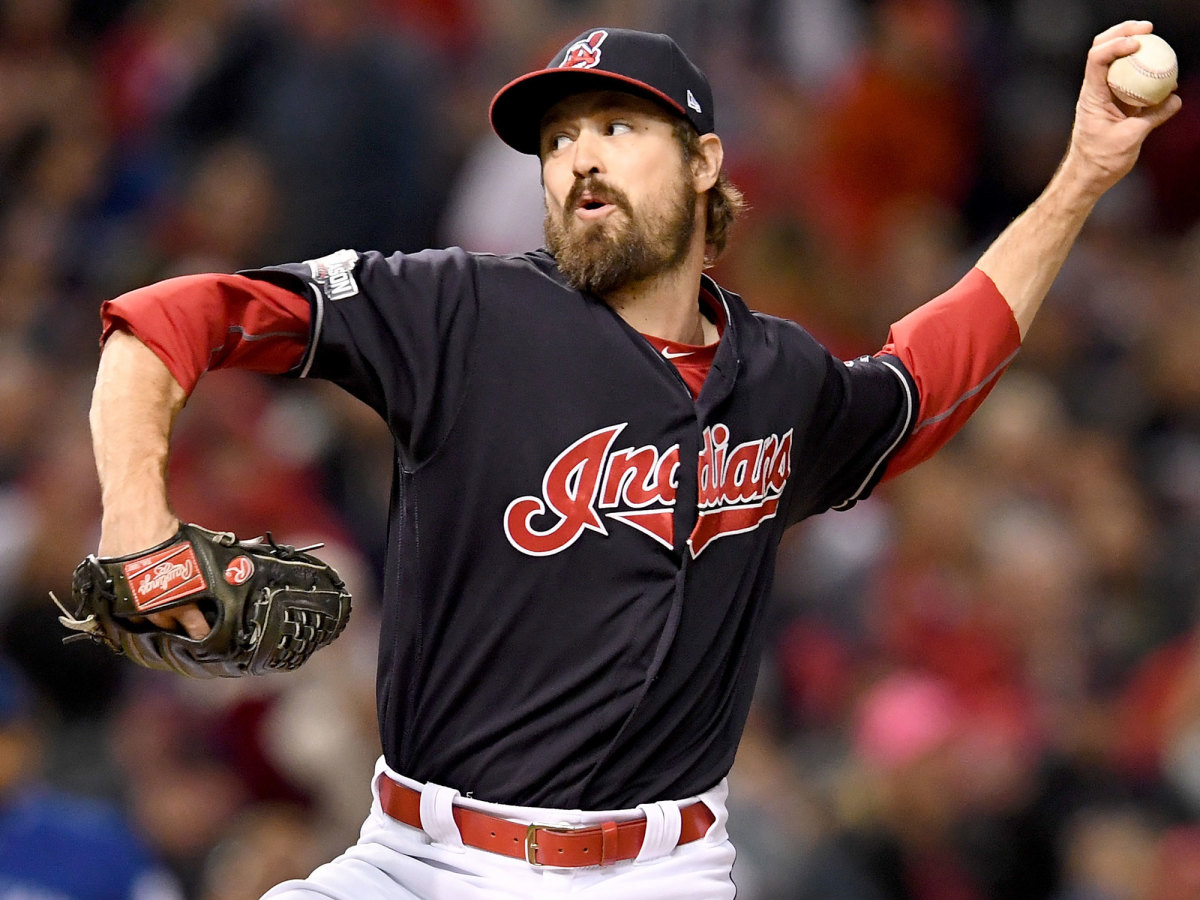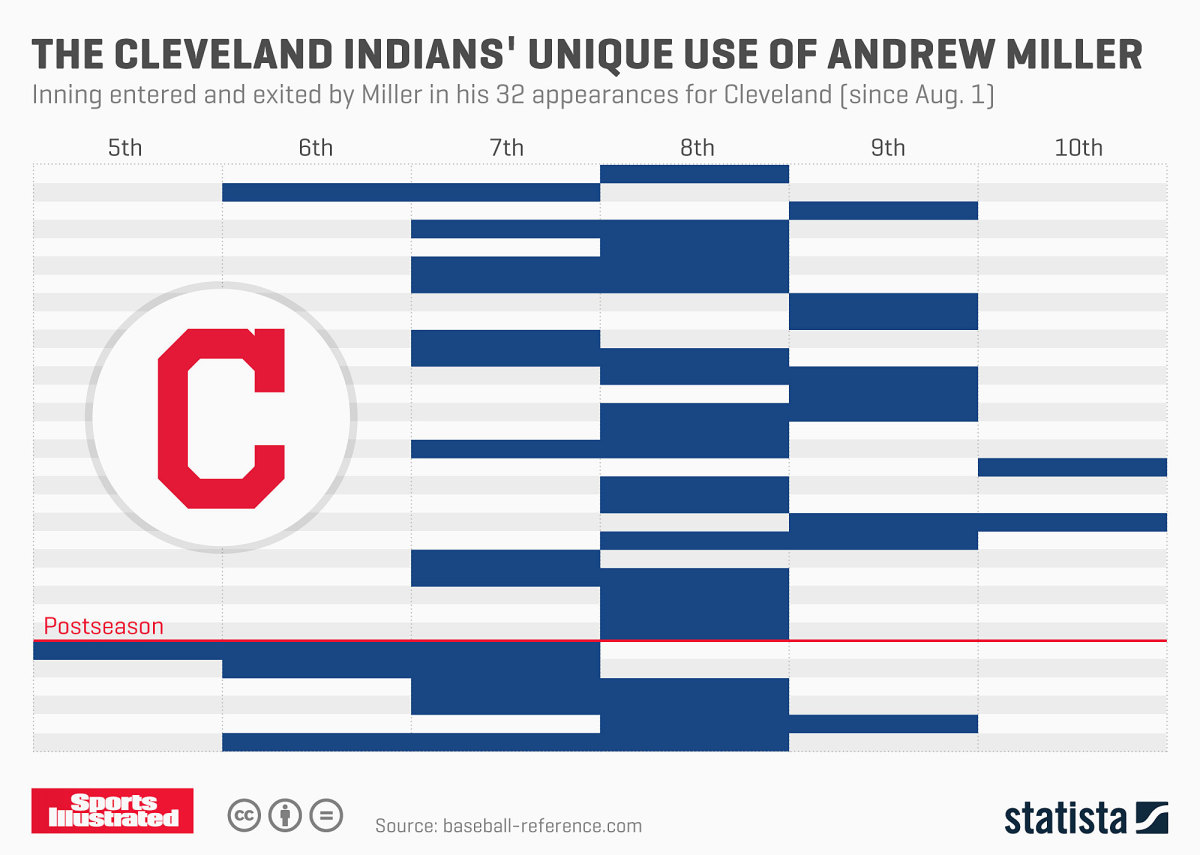Andrew Miller: Inside his journey to a new type of October dominance

Watch the historic 2016 World Series live on Fox. Game 1 is Tuesday night at 8 p.m. ET.
Closers: They enter games to head-thrashing theme songs, by AC/DC and Metallica. They wear fussily groomed handlebar mustaches, goatees and mullets, to better frame their scowls. They dangle their menacing pitching arms from their sides. They have their skin and the license plates of their Lamborghinis engraved with numerals representing their triple-digit fastballs. They pump their fists, they cross their wrists to form the letter X, they shoot pretend arrows into the sky from pantomimed bows. But few have ever played the role in the way of Andrew Miller.
“My shtick is that I’m trying to be as boring as possible and focus on getting outs,” he says. After some contemplation, he admits to one eccentricity: “I don’t wash my jock strap until after I have a bad game.”
Spare a thought for the Indians' clubhouse attendant who will eventually have to contend with the undergarment. It has now been seven weeks, and 17 sweaty outings, since Miller has allowed a run. The last six of those appearances have come in the playoffs—11 2/3 innings in which he yielded five hits and two walks and struck out 21 hitters. Miller was named the MVP of the ALCS; he would have been the MVP of the ALDS, too, if the award existed.
It is difficult to envision a scenario in which the Indians would have advanced to the World Series without him, and not just because of his numbers. Make no mistake: Miller is a closer, in that his arrival on the mound means that his opponents can adjust their focus to the following evening. Cleveland has won the last 16 games in which he has pitched. But he’s different from the standard model in style, as his outings are not at all limited to the ninth inning when his club leads by three runs or fewer—save opportunities, as officially defined since 1969. Contending with September injuries to Carlos Carrasco and Danny Salazar, two of his top three starters, Indians manager Terry Francona’s usage of Miller has been as simple as it has been unorthodox: Wait for a lead, then entrust Miller to get as many outs as he can. He has so far entered playoff games in the fifth inning, the sixth, the seventh and the eighth. The results have always been the same.
Miller is just the fifth reliever ever with 20 strikeouts in a single postseason, and he has done it in fewer innings than the other four and is the only one with a spotless ERA:

Miller, who has 49 career saves, including 36 last season with the Yankees, admits that he loves pitching the ninth. “There’s some ego thing,” he says. “It’s really cool to be the last guy out there and to get the last out.” But he has flourished in his role in Cleveland, for several reasons.
One: He understands it. “Maybe, as more and more stats come out, we realize there’s bigger moments in the game than the eighth and ninth inning, and that can be appreciated,” he said late on Oct. 6, after he had come on for starter Trevor Bauer with two outs in the fourth in Game 1 of the ALDS against the favored Red Sox and thrown 40 pitches over two shutout frames. Miller’s quote irrigated the cracked throats of baseball progressives, who decry the forty-year-old convention that a manager ought to use his best reliever only at the end of games, when earlier situations might prove more critical. Only two nights before, the baseball world had pilloried Orioles skipper Buck Showalter for losing the AL wild-card game to the Blue Jays without the benefit of a single pitch from Zach Britton, he of the 0.54 ERA. To them, Miller represents the mutation that will spur an overdue evolution—a player who gets it.
A second reason: His stuff overpowers, no matter when he throws it. Of the many statistics that indicate that, including a 144/11 strikeout-to-walk ratio in his 86 total innings so far this year, one truly astonishes: According to FanGraphs, hitters swung at a higher percentage of pitches he threw outside of the strike zone (40.5%) and at the same time took a lower percentage of his pitches that ended up in the zone (53.5%) than they did against any other hurler who worked as much as he did this season. To batters, quite simply, his strikes look like balls and his balls look like strikes.
An MLB scout on the strengths and weaknesses of the Cubs and the Indians
It’s not that hitters can’t guess what’s coming. Miller throws only two pitches: about 40% of the time a fastball that sits at 94 mph and can reach 99; and a swooping, plunging mid-80s slider the rest of the time. It’s that hitters have no idea how to go about hitting it. That’s partly because they have no experience facing anyone else quite like him, a 6’7” lefty with not just gas but also a slider that looks as if it’s going to be several feet off the plate before whipping over its heart. Comparisons are hard to come by, and always inexact: a shorter Randy Johnson; a more upright Chris Sale; a taller Clayton Kershaw.
“If you think about it, his slider is coming out of the same window as his fastball,” says Cody Allen, who is usually the Indians’ closer in the traditional sense. “He throws two sliders that are back foot to a righty. They’re both balls. They swing and miss at both of them. So they’re telling themselves, do not swing down and in. Now he throws a fastball from the same tunnel, and it locks them up.”
There is a third explanation for why Miller has happily prospered outside of a role about which most relievers of his abilities are proprietary. “If you’re a young kid and you haven’t made any money, the best way to make money is to get some saves,” Francona says. For now, anyway, baseball’s economics reward the stat, in both arbitration and free agency. Miller, who is active in the players’ union, readily concedes that he is currently working without that motivation, as he is completing the second season of a four-year, $36 million deal he signed with the Yankees in December of 2014. “We all make a lot of money in this game, and we’re very fortunate,” he says. “Everyone wants more. But I don’t have a financial incentive to go out there and say, ‘I've got to be the closer.’ I’m not building any resume for free agency, based on saves, or even any Hall of Fame case.”
Miller, then, possesses the wokeness, the game and the bank account to have become, at 31, not just this postseason’s breakout star but also a harbinger of baseball’s future. There’s also one more reason why it has happened.

When Burke Badenhop watched Andrew Miller pitch in 2009, he could hardly recognize his friend. The Tigers drafted Badenhop in '05, one year before they selected Miller. In the minors they recognized each other as kindred spirits, guys who were passionate about baseball but who had attended college and had other interests: books, politics, music, the world outside the clubhouse. Their bond became adamantine in December of 2007, when they were traded together, along with four other players, to the Marlins for Miguel Cabrera and Dontrelle Willis. That deal’s blockbuster nature meant that they would both receive more public scrutiny than most young and developing players—especially Miller.
There were a few differences between them. While Badenhop was a 19th-round righty out of Bowling Green who got along on guile, Miller threw near 100 from the left side at the University of North Carolina and was considered his draft’s top prospect, eventually selected with the No. 6 pick in a loaded class that also included Evan Longoria (No. 3), Kershaw (No. 7), Tim Lincecum (No. 10) and Max Scherzer (No. 11). The first time the two played catch, Badenhop could barely get leather on Miller’s throws. “He was handcuffing me, giving me trouble from 90 feet,” Badenhop says. “The ball out of his hand was different. It just was. So much velocity, life, carry, everything.”
By 2009, though, Miller looked nothing like the pitcher Badenhop had first met. “He was pitching like Kareem Abdul-Jabbar would take hook shots,” Badenhop say. “He was throwing over the top, kind of leaning into it. And it’d be coming in at 88 to 90. [It] just was not good.”
Miller had become infected with the tall pitcher’s disease: wildness. He had debuted with the Tigers less than three months after they’d drafted him but had walked 10 batters in 10 1/3 innings. His attempts to find a cure only made things worse. “In the game of baseball, unfortunately, smarts don’t always play to your favor,” Badenhop says. “You can basically outsmart yourself, and Andrew’s a real smart guy.” As those early years progressed and he found himself in Florida, Miller tried to incorporate almost every tweak suggested by well-meaning tutors, but the result was a Frankenstein’s monster of a delivery that scared no one except experts in biomechanics. Says Badenhop: “All he wanted to do was be really good, man. But at the same time he’s not a stubborn guy, so he’d listen to his coaches, want to please people.” By 2010, his final year with the Marlins, the 25-year-old Miller had compiled a 5.84 ERA in 79 career appearances for Florida, 54 of them starts.
World Series Case For: Cubs, Indians each look to end title drought
Ben Cherington had been watching all along. Cherington directed the Red Sox’ scouting department, under general manager Theo Epstein, and he saw Miller pitch a game for North Carolina back in 2006. Cherington was under no illusion that the Red Sox might draft Miller: Their first pick that year was 27th overall, long after they might have had any shot at him. Cherington had gone to Chapel Hill to scout Miller’s teammate, another hard thrower named Daniel Bard. He did end up with Bard, but he never forgot the eight innings he saw Miller pitch against NC State. “It just looked like such a hard at-bat,” Cherington says. “Different angles, different stuff. He just looked very uncomfortable to hit off of.” Even as Miller struggled in the pros, Cherington looked deeper. “This is a different animal,” he told himself, “if he’s capable of doing what he’s capable of doing.”
Although Miller was out of options, meaning that he couldn’t be sent to the minors, Cherington encouraged Epstein to trade for him even though the Red Sox had no open spot on their roster. Epstein did, in Nov. 2010, in exchange for reliever Dustin Richardson. Boston’s personnel crunch meant the team had to cut Miller a few weeks later, but in an attempt to persuade him to return on a minor league deal, the Red Sox presented him with a development plan that detailed why they were the team to help him save his career. Though he had other suitors, he signed the deal.
Cherington didn’t watch Miller’s first outing the following spring. Epstein texted a live report: Dude, seriously, with Miller? Cherington’s heart sank. Then his phone pinged with the puckish GM’s follow up: This couldn’t have gone any better.
Miller’s time in Boston wasn’t always smooth. He played for three managers in four seasons—Francona, Bobby Valentine and John Farrell—and suffered two injuries, a strained hamstring and then torn ligaments in his foot. The first put an end to his days as a starter, and the second caused him to miss the club’s World Series run in 2013. Still, the Red Sox did what they had promised. They helped him find his mechanics, which meant simplifying and shortening them. He eliminated his windup and threw from a lower arm slot, even if it meant sacrificing a few miles per hour of potential velocity. “The quicker he got to the plate, the better he was, because he was able to be more connected with his delivery,” says Juan Nieves, his pitching coach starting in '13. They also helped him find his place in the game; it wasn’t as a starter. “I had my chance,” Miller says. “Bullpen was the way to go.”
The Red Sox acquired Badenhop from the Brewers prior to the 2014 season, and he again found himself in the same clubhouse as his friend. Miller still possessed the physical traits that he had when they had last played together, four years earlier. His lankiness still made it look, to hitters, as if he was releasing the ball halfway to home plate. When Badenhop pitched after Miller, he’d laugh at the divots Miller had left with his landing foot, because they were so far down the mound. “I don’t even think the grounds crew rakes that spot,” Badenhop says. Now, though, he had become the type of pitcher that he always ought to have been. In 42 1/3 innings with the Sox that year, he struck out 69 batters and walked just 13, with a 2.34 ERA.
Indians’ belief in Terry Francona shown in magical World Series run
Those numbers were too good for a soon-to-be free agent on a last-place team. Cherington, now the GM, traded Miller to the contending Orioles at the deadline. It wasn’t a bad deal, yielding pitching prospect Eduardo Rodriguez, one of the many talented young players with which Cherington—whom the Red Sox fired the following August and who is now in the Blue Jays' front office—seeded this season’s AL East champions. But it is a trade that Cherington would take back.
“In hindsight, what we should have done is re-signed him,” Cherington says. “I think we probably had a chance to. But we were probably being guided, a little bit, by the conventional wisdom around big, long-term deals for non-closer relievers—even though, clearly, he had the stuff to close. Those types of deals were uncommon at the time. The ones that had happened hadn’t turned out well. What we didn’t realize clearly enough, at the time: Andrew Miller is an uncommon pitcher and had to be treated in an uncommon way.”
Miller was even better for the Orioles: He had a 1.35 ERA in 20 regular-season innings, followed by five straight scoreless appearances in the playoffs. The experience taught him that his stuff would hold up even through an unexpected change of clubs. That was one of the first thoughts that crossed his mind last July 31. He was enjoying one of his few in-season chances to sleep in his own bed, at his home in Tampa—the Yankees had a day game against the Rays—when his phone started to peal at 8 a.m. Certain he had set it for nine, he rolled over and looked at the screen: BRIAN CASHMAN, it read. Even before the Yankees’ GM officially informed him that he’d been traded for several top prospects, he knew that he was about to become a member of his sixth club. The next day, he threw his first pitch for Cleveland.

Miller is not a person who would be lost without baseball. He considered quitting a few times, during his Abdul-Jabbar days, with no existential crisis. He is from a stable, comfortable family, the only child of David—a semi-retired accountant and commercial real estate developer—and Kim, a pediatric nurse who has had to miss a few of his playoff games this month to teach her classes at Florida’s Indian River State College. When Miller was growing up in Gainesville, Fla., he regularly played catch with his mother, until he was about 15 and she, like Badenhop eventually would, found herself handcuffed one too many times. His father took over, though his son’s throws would regularly blow out the pocket of his glove. David, a former high school outfielder, stands 5’11” and says his arm was never particularly strong. “My wife’s got some uncles that are almost seven foot tall,” he says. “I think the height came from his mom’s side.”
Miller is married and has a three-year old son, Max. “We’ve gone to a lot of wine country type stuff—a little in France, one year,” he says, of his favorite activities with his wife of six years, Katie. “Ultimately, things revolve around Max. Probably like your world.” He loves fantasy football and still participates in a league with other guys whom the Tigers drafted in 2005 and '06, though he is the only one still in pro baseball. “We had our draft, swapping stories from A-ball,” says Badenhop, who last pitched for the Reds in 2015. Miller’s team is named If You’re Not First You’re Last, a reference to the Will Ferrell movie Talladega Nights. Badenhop’s is The Dirty Randys, a reference to the FX TV show The League.
Miller was a business major at UNC; if not for baseball, he would have pursued a career in finance. “I wasn’t going to be an astronaut or anything like that,” he says. His parents tease him that while they both have advanced degrees, he left college after his junior year before completing his bachelor’s. “How’s that working out?” he teases back. This is about the extent of his trash talk. “Real down to earth,” Badenhop says. “You wouldn’t know this guy’s the best reliever in baseball, bar none, the last couple years.”
Indians’ ALCS celebration gives look inside their family-first clubhouse
When Miller arrived in Cleveland, Badenhop—who is part of an active text messaging group with him and Craig Breslow, another reliever from their Red Sox days—tried to persuade him to make a splash in his new hometown. Have a Bone Thugs song played the first time you get in a game, Badenhop texted, referring to the city’s most famous rap group, Bone Thugs-n-Harmony. People’s heads would explode. Just do it.
Man, I’d really like to, Miller replied. I’m not the guy for that kind of thing.
This speaks to the fourth reason why Miller has seamlessly, and enthusiastically, taken to his pioneering role with the Indians: He does not view himself as a superstar, one inclined to make demands as far as a theme song or when and how much he plays, because for a long time he was far from one. “I think he knows where he has come from, and the last thing he wants to do is go back to being the Andrew Miller who was in Double A after having two years of service in the big leagues,” Badenhop says. “I think he’s very happy to be in the majors and doesn’t want to take anything for granted. I think he understands that when he pitches well, it’s an absolute blessing. He’s just happy with being a good pitcher.”
“The struggles I went through,” Miller says, “helped make me who I am today.”
Miller’s father says he has always been adaptable. “He was like a dad’s dream, to me,” he says. “I would load him up in my car and take him hunting when he was six or eight months old. Put him in the car seat, mom would go to work and we’d go riding around in the woods all day. He’s never been a complainer.”
World Series: Running bases, returning sluggers and more keys to Cubs-Indians
In mid-summer, back when the Indians’ rotation was as stacked as anyone’s and they were looking to shore up their bullpen, they negotiated for every top reliever who might conceivably become available. Their targets included Aroldis Chapman, Miller’s bullpen mate with the Yankees. Once it became apparent that the asks for all of them were exorbitant—two top-100 prospects, to start—Miller’s flexibility, born of both his nature and his specific experience and attested to by Francona, made him Cleveland’s top choice.
“It was a huge factor for us,” says GM Mike Chernoff, and not only because of the singular weapon with which he’d be arming the creative Francona. “Think about it. A guy with the numbers that he has, the background that he has, that has to set a tone for every other guy in our bullpen and the entire clubhouse. How could anybody come and say that they want it to be about them, at that point?”
The Chapman trade worked out for both parties, too; he ended up with the Cubs. Now the Yankees have the league’s most fecund farm system, and Chicago and Cleveland have a pair World Series relief aces. But while Cubs manager Joe Maddon’s deployment of Chapman has been a bit less conventional than usual, he still hasn’t pitched earlier than the eighth inning this October. By Nov. 3, at the latest, one of baseball’s two longest championship droughts will have ended: the Cubs’ at 107 seasons or the Indians’ at 67. A less certain result is whether Miller’s postseason will have really portended the eventual death of the traditional closer.
This graph, from Statista.com, shows how the Indians have used Miller since acquiring him from the Yankees. Each row represents an outing:

That's hardly the breakdown of a traditional closer. Closers like their roles not just because of the glory and the money, but because many of them know that they would not be nearly as dominant if they had to be ready to work at any point on a given evening, for an undefined number of outs. “If I know I’m only pitching the ninth inning with a lead of one to three runs, it’s very easy to prepare for that kind of situation,” Miller says. In fact, despite his words after his fifth-inning entrance in the ALDS, he isn’t entirely convinced that the way he’s being used would be ideal for a team with a less dire starting pitching situation than that of the Indians. “I wouldn’t say I’m super progressive,” he says. “You go to websites like FanGraphs, and you see all the arguments that are made. But I don’t think anybody can say they’ve figured it out.”
Cherington is a bleeding-edge progressive, but even he isn’t sure of what the future holds. “It’d be optimal for teams to have a pitcher who is willing to pitch in that role and be effective in that role, but easier said that done,” he says. “I think it depends on the personnel teams have at their disposal, and if their guys are physically able to do it. You could imagine Mariano Rivera doing this kind of thing, because of the way he pitched and how efficient he was. It certainly didn’t hurt the Yankees not to use him that way. But for most other guys, I don’t know if they could throw 40 pitches and come back the next night, then have one night’s rest and do it again. There’s not a lot of guys that can do that.”
To Allen, there are notably few. “There’s no other Andrew Millers out there,” he says. “There’s one. And we got him.”
